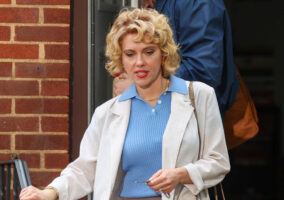![]() Pin
Pin
You can’t do it. You simply can’t look at the above picture – or any pictures of this costume – without hearing the words “Tell me about it, Stud.”
There’s no denying that Olivia Newton John’s final costume in 1978’s Grease is iconic. It’s the one costume from the film everyone remembers and in many ways, it’s the defining image of Newton-John’s career. It was always going to be included in this series, but we admit, we’ve been putting it off for some time now because if we’re going to examine it, then we have to point out the undertones of it that are very specific to its time and haven’t particularly aged all that well.
![]() Pin
Pin
![]() Pin
Pin
![]() Pin
Pin
But before we do that, let’s start here: There’s very little about this look that could be considered historically accurate for the period of the film, although it’s not completely off-base. While the spandex pants and curly hair owe way more to the late ’70s, there’s at least a tip of the hat to the kinds of looks worn by biker chicks in Southern California biker culture of the late ’50s and early ’60s, especially the winged eye and moto jacket. But a true biker chick wouldn’t have been caught dead in those Candie’s mules or those hoop earrings.
![]() Pin
Pin
The seventies was a decade fairly obsessed with the period from the mid-1950s to the early 1960s; from American Graffiti to Happy Days, The Lords of Flatbush to Sha Na Na, American Hot Wax to The Wanderers, Laverne & Shirley to The Rocky Horror Picture Show (which was not set in the ’50s but still functioned as one long homage to the B films and music of the decade). There are, we’d argue, two reasons for this. The first is basic, simple, and easy to comprehend: Baby Boomers, like Gen-X and Millennials after them, spent their twenties and thirties obsessing over the youth culture of their childhood. The reason you’re seeing so many retrospectives on the early aughts right now is because Gen-Z is entering their twenties. It’s why That ’70s Show and the Brady Bunch movies were so popular in the ’90s; because Gen-X was in their twenties at the time. But Boomers were the first generation to foster this sort of nostalgic obsession, mainly because they were the first generation to grow up with a mass-mediated pop culture landscape devoted to teenagers.
![]() Pin
Pin
But unlike the generations that followed them, Boomers oversaw a massive cultural and aesthetic shift, the likes of which have not been duplicated since. Go look at high school yearbook photos in 1958 and 1968. You’d think they were taken a century apart. And those members of the “Silent Generation,” the ones who were slightly older than Boomers but not old enough to be called part of The Greatest Generation ( adults during the Depression and WWII), who hit their thirties and forties in the 1970s, were themselves nostalgic for a time when rock and roll seemed more fun and light, rather than the disheveled rock and Glam Rock of the post-Woodstock era.
![]() Pin
Pin
The point to all this? While Boomers and their immediate forebears were obsessed with the music and culture of the previous era, they were far less interested in duplicating it accurately. By the 1970s, people thought the lacquered bouffants, crinolines, bullet bras, cat-eye glasses, ducktail pompadours, varsity jackets and crew cuts of the 1950s and ’60s not only looked ridiculous, but were evident of a less enlightened time; a time before women burned their bras (apocryphally, if not actually) and before men grew their hair long.
![]() Pin
Pin
In other words, unlike the nostalgic obsessions of Gen-X and Millennials, the Boomers wanted to look back on the youth culture of their childhood while filtering it through the cultural and aesthetic changes that happened in the years since. This is why Happy Days, Laverne & Shirley and Grease look way more like the decade in which they were produced than the decade they were depicting.
![]() Pin
Pin
And because this is 1978, eleven years post-sexual revolution, at a time when sexual expression and sexual freedom were ruling the pop charts, the runways, and the discos, this costume represents a very ’70s-specific perspective; one that upends one of the most basic and repeated costume tropes in cinema history: the makeover. But before we get into that, let’s note the most obvious point that this costume is making.
![]() Pin
Pin
![]() Pin
Pin
In order to keep Danny Zuko, Sandy had to more or less become Danny Zuko: black leather jacket, tight black shirt, tight black pants, big hair. They’re a fully matched pair and the moment is presented not only as a triumph, but as their happy ending. This is the part of it that’s a bit notable if not problematic by modern standards.
![]() Pin
Pin
While there have been plenty of films that sent problematic messages to young women in the years since 1978, we can’t recall many that told them they had to turn themselves into a female version of their boyfriend in order to hold onto him. There’s nothing in Newton-John’s portrayal or the script itself that indicates that this is what Sandy wants or that this reveal is who she really is. If anything, the film indicated the exact opposite for the entirety of its running time.
![]() Pin
Pin
Note that Danny tried to become the kind of boyfriend he thought Sandy wanted by trying out for sports and not pressuring her into sex, only to come to the realization that he’s better off being true to himself because he was ill-suited to team sports and perpetually horny. He starts off the scene wearing his varsity sweater and immediately sheds it when she shows up. Sandy’s arc is the exact opposite of his. She spent the film asserting her own needs, her own background and what she was comfortable expressing about herself – only to ditch it all in the end to keep Danny happy.
![]() Pin
Pin
![]() Pin
Pin
Note that the ponytails, cardigans, anklet socks and demure shirt dresses of her earlier wardrobe (which were actually more period-accurate than this look) were presented as something to deride. The entire “Look at Me, I’m Sandra Dee” number is built on the idea that Newton-John’s period-accurate persona was something that she needed to just get over. That song wouldn’t have made much sense in 1958 because it was coming from a purely 1978 perspective. “Good” girls in 1958 were celebrated, but by the late ’70s, they were figures of derision. That perspective is built into this costume and it’s why this look stands out in the history of cinematic makeovers.
![]() Pin
Pin
From My Fair Lady to Pretty Woman; from The Devil Wears Prada to The Princess Diaries, the cinematic female makeover has typically been about taking a tacky woman or unassuming woman to a point of high glamour and high class. It was almost always about turning an “ugly” girl into a swan, a low-class woman into a princess.
![]() Pin
Pin
![]() Pin
Pin
Olivia Newton-John’s makeover in Grease is the exact opposite in tone. It was about turning a “good” girl into an appropriately sexually available one. Because in 1978, at the height of the let-it-all-hang-out era, while the discos were filling up with coke-fueled party-goers, self-actualization for women in pop culture was partly measured in how open they were to having sex; how much they were willing to signal that in their clothing and style.
![]() Pin
Pin
![]() Pin
Pin
This isn’t a criticism. Films exist as signifiers of the times in which they were made and the 1970s was a time in pop culture that absolutely prioritized one’s willingness to party and fuck. Freedom was measured by how much you were willing to let it all hang out and ditch the restrictions and morality of the past. In 1958, Sandy’s happy ending would have had her walking down an aisle in an appropriately virginal-white wedding gown marrying the man of her dreams. In 1978, however, her happy ending was all about showing her man she was DTF and willing to change every essential part of herself to hold onto him. In the context of the times, that was seen as the more progressive way of looking at it.
[Stills: Universal Pictures via Tom and Lorenzo]
Heidi Klum in Redemption on “America’s Got Talent” Next Post:
Jennifer Lopez Poses with Her Mom and Twins for Coach Ad Campaign
-
 Pin
Pin
Scarlett Johansson Filming PAPER TIGER in New York City
-
 Pin
Pin
The Wardrobe Department: Aimee Lou Wood’s Chelsea Wears Alexander McQueen on THE WHITE LOTUS
-
 Pin
Pin
The Wardrobe Department: Lalisa Manobal’s Mook Wears Mitr on THE WHITE LOTUS
Please review our Community Guidelines before posting a comment. Thank you!
